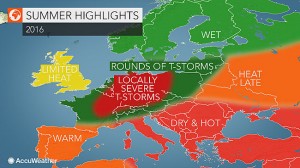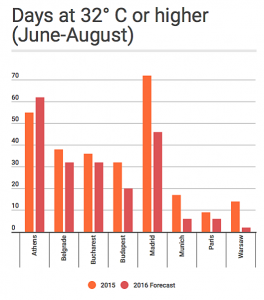Limited heat, bouts of rain forecast for UK and Ireland
High pressure sitting to the west of Ireland and the U.K. will keep extreme heat at bay and also direct Atlantic depressions between Iceland and the British Isles.While the center of the depressions will often pass near or north of Scotland, rain will frequent much of the U.K. with the heaviest falls expected in Northern Ireland, western Scotland and northwest England. “After a wet start to 2016, the unsettled weather will continue into the summer months, which means there could be enhanced localized flooding, especially in areas that are trying to still clean up from the floods in early winter,” AccuWeather Meteorologist Tyler Roys said. Frontal boundaries accompanying the depressions will sweep through the U.K. and Ireland, ending any warmth and resulting in seasonable temperatures for much of the summer months. The frequency of these fronts and a flow off the Atlantic Ocean for much of the summer will result in no extended heat waves for the Isles. These fronts will also bring occasional thunderstorms with downpours, lightning and small hail.
Frequent storms, occasional heat to stretch from Paris to Berlin and Warsaw
The predominant storm track for the summer months will send storms from the north Atlantic Ocean eastward into Scandinavia and the Baltic states. The result of this pattern will be occasional heat building northward and interacting with cold fronts racing eastward across western and northern Europe.
This interaction will result in numerous episodes of rain and thunderstorms from France into Germany, Poland and the Baltic states.
Some of the storms will be severe with the greatest threat for damaging storms in eastern France, Belgium, Netherlands, Germany, western Czech Republic and western Poland. The strongest thunderstorms will produce damaging winds, hail and even isolated tornadoes.Flash flooding will also be a concern due to slow-moving thunderstorms, with the greatest threat stretching from eastern France into southern Germany and western Czech Republic. While extended heat waves are not expected, one to two days of intense heat are possible ahead of each cold front.
Dry, hot summer in store for Italy and Balkans
While storms bring relief from any intense heat in western and northern Europe, southern Europe will be sweating this summer as long stretches of above-normal temperatures and dry weather dominate.
The core of this heat will build from central and southern Italy into the southern Balkans and expand northward in July and August.According to AccuWeather Senior Meteorologist Alan Reppert, “The heat in the southern Balkan Peninsula could result in the warmest summer in recent years.” The heat will be felt over northern Italy, Romania, Moldova, Hungary and Slovakia in July with the hottest days of summer occurring in August across Ukraine and Belarus.
Along with the building heat, drought will be a concern from southern Italy into Greece and the southern Balkans. Drought will bring an increased risk for water shortages, poor crop yields and wildfires. The greatest risk will be from July into August when the drought worsens and lightning from isolated thunderstorms can trigger fires. “This will be the second straight year with a hot summer that will feel unbearable at times. People need to stay hydrated and watch after the elderly and young, especially in the afternoon,” Roys said.
The drought is expected to build into Serbia and southern Romania during the second half of the summer. Thunderstorms caused by weak frontal passages will bring some beneficial rains to areas from Austria to northern Romania and Moldova.
A visitor cools off next to the Great Britain pavilion at the Milan Expo 2015 world’s fair in Rho, near Milan, Italy, Monday, Aug. 3, 2015. (AP Photo/Antonio Calanni)
Warmth to prevail over Iberian Peninsula; frequent rain to fall in Scandinavia
Overall, a summer with near-normal temperatures and precipitation is expected across Spain and Portugal. While there will be heat, the summer will be cooler compared to last summer when Madrid experienced 72 days with temperatures 32 C (90 F) or higher from June through August.
“Mild nights are expected across the Iberian Peninsula this summer, resulting in above-normal temperatures overall,” Reppert said.
Following a wet pattern during the spring, conditions will turn drier in June with occasional light rainfall, especially in northern Portugal and northern Spain. During the months of July and August, drier overall weather is expected with isolated thunderstorms. Most of these storms will occur in the higher terrain during the afternoon and evening hours. A few of the storms will drift into the lower elevations and will bring beneficial rainfall. “The drought that has impacted parts of the Spain the past several years will plateau or even improve slightly in some areas,” Roys said.
A few of the strongest fronts expected to pass through northern Europe will reach northern Spain, triggering more widespread showers and thunderstorms and bringing the threat for downpours and flash flooding to the Pyrenees.
Meanwhile, areas from Scandinavia to the Baltic states will experience a wetter-than-normal summer as frequent storm systems pass through the region. These storms will bring rain and occasional thunderstorms along with cooler-than-normal air to the region.
The high frequency of wet and cool days will result in below-normal temperatures for the summer months and also keep any intense heat from building into the region throughout the season.
Eric Leister, www.accuweather.com Περιορισμένη ζέστη και σποραδικές βροχές σε Ηνωμένο Βασίλειο & Ιρλανδία
Περιορισμένη ζέστη και σποραδικές βροχές σε Ηνωμένο Βασίλειο & Ιρλανδία
Περιορισμένη ζέστη και βροχές ανά διαστήματα προβλέπονται για το Ηνωμένο Βασίλειο και την Ιρλανδία. Η υψηλή πίεση που παραμένει στα δυτικά της Ιρλανδίας και του Ηνωμένου Βασιλείου αφενός θα κρατήσει την ζέστη στους κόλπους αφετέρου θα οδηγήσει το βαρομετρικό χαμηλό από τον Ατλαντικό μεταξύ Ισλανδίας και Βρετανικών Νήσων. Αν και το κέντρο των βαρομετρικών χαμηλών θα περνάει συχνά από τα βόρεια της Σκωτίας, αναμένονται συχνές βροχές στο Ηνωμένο Βασίλειο με τις περισσότερες να εντοπίζονται στα βόρεια της Ιρλανδίας, στα δυτικά της Σκωτίας και στα βόρεια της Αγγλίας.
Συχνές καταιγίδες και περιστασιακή ζέστη σε Παρίσι, Βερολίνο και Βαρσοβία
Σύστημα καταιγίδων από το Βόρειο Ατλαντικό αναμένεται να κινηθεί ανατολικότερα επηρεάζοντας την Σκανδιναβία και τις περιοχές της Βαλτικής. Ως αποτέλεσμα αυτού θα δημιουργείται περιστασιακή ζέστη στα βόρεια και θα αλληλεπιδρά με ψυχρά μέτωπα που θα κινούνται από την δυτική στην ανατολική Ευρώπη. Αυτή η αλληλεπίδραση θα προκαλέσει βροχές και καταιγίδες από την Γαλλία μέχρι την Γερμανία, την Πολωνία και τις Χώρες της Βαλτικής. Ορισμένες καταιγίδες αναμένονται να είναι ισχυρές. Η μεγαλύτερη απειλή εντοπίζεται στην ανατολική Γαλλία, το Βέλγιο, την Ολλανδία, την Γερμανία, την δυτική Τσεχία και την δυτική Πολωνία και είναι πολύ πιθανό να προκαλέσουν καταστρεπτικούς ανέμους, χαλάζι ακόμη και μεμονωμένους ανεμοστρόβιλους. Οι πλημμύρες αποτελούν ένα ζήτημα το οποίο θα κληθούν να αντιμετωπίσουν. Δεν αναμένονται παρατεταμένα κύματα ζέστης.
Καυτό αναμένεται το φετινό καλοκαίρι για Μεσόγειο και Βαλκάνια!
Καυτές θερμοκρασίες και ξηρασία προβλέπονται για το φετινό καλοκαίρι στην Νότια Ευρώπη καθώς αναμένεται παρατεταμένη ζέστη σε συνδυασμό με ασυνήθιστα υψηλές για την εποχή θερμοκρασίες. Στην Ελλάδα, όπως φαίνεται και από το παρακάτω γράφημα, το διάστημα Ιουνίου-Αυγούστου, αναμένονται πάνω από 60 ημέρες με θερμοκρασία άνω των 32 βαθμών Κελσίου λιώνοντας μας κυριολεκτικά!
Η “καρδιά” της ζέστης θα δημιουργηθεί στο κεντρικό & νότιο τμήμα της Ιταλίας στα Νότια Βαλκάνια και θα επεκταθεί προς τα βόρεια τους μήνες Ιούλιο και Αύγουστο. Σύμφωνα με τον έμπειρο μετεωρολόγο του Accuweather Alan Reppert, “Η ζέστη στην Βαλκανική Χερσόνησο θα μπορούσε να προκαλέσει το πιο καυτό καλοκαίρι των τελευταίων ετών.”
Τον καύσωνα θα “νιώσουν” η Β. Ιταλία, Ρουμανία, Μολδαβία, Ουγγαρία, Σλοβακία τον Ιούλιο με τις πιο καυτές μέρες σε Ουκρανία και Λευκορωσία να εντοπίζονται τον Αύγουστο.
Μαζί με τον καύσωνα, η ξηρασία που αναμένεται να επικρατήσει είναι ένα ζήτημα για την Ν.Ιταλία, την Ελλάδα και τα Ν. Βαλκάνια, καθότι ενδέχεται να προκαλέσει λειψυδρία, προβλήματα στις καλλιέργειες αλλά και εκδήλωση πυρκαγιών. Η μεγαλύτερη απειλή εντοπίζεται από τον Ιούλιο μέχρι τον Αύγουστο όταν η ξηρασία θα χειροτερεύει και μπορεί να συνδυαστεί με κεραυνούς που θα προκληθούν από μεμονωμένες καταιγίδες.
“Αυτός θα είναι ο δεύτερος σερί χρόνος με ένα καυτό καλοκαίρι που θα μας κάνει να αισθανθούμε κατά καιρούς ανυπόφορα ”. Οι πολίτες πρέπει να φροντίζουν να είναι ενυδατωμένοι και να προσέχουν τους μεγαλύτερους και πιο νέους, κυρίως τις απογευματινές ώρες “ λέει ο Τyler Roys, μετεωρολόγος του Accuweather.
Η ξηρασία αναμένεται να ξεκινήσει στην Σερβία και στην Νότια Ρουμανία κατά την διάρκεια του 2ου μισού του καλοκαιριού. Οι καταιγίδες που θα προκληθούν από την διέλευση ασθενών μετώπων θα φέρουν κάποιες βροχές που θα επωφελήσουν περιοχές της Αυστρίας και Βόρειας Ρουμανίας και Μολδαβίας.
Ζέστη στην Ιβηρική Χερσόνησο-συχνές βροχοπτώσεις στην Σκανδιναβία
Γενικά, το καλοκαίρι θα κυλήσει με κανονικές για την εποχή θερμοκρασίες στην Ισπανία και Πορτογαλία. Αν και θα έχει ζέστη, οι θερμοκρασίες θα είναι πιο δροσερές συγκριτικά με αυτές του προηγούμενου καλοκαιριού. “Η ξηρασία που είχε προκαλέσει επιπτώσεις στην Ισπανία τα τελευταία χρόνια θα σταθεροποιηθεί ή και θα βελτιωθεί σε ορισμένες περιοχές” λέει ο Τyler Roys. Στο μεταξύ, περιοχές από την Σκανδιναβία και Βαλτική θα αντιμετωπίσουν ένα πιο υγρό από τα συνηθισμένα καλοκαίρι καθότι συχνά συστήματα καταιγίδων θα κάνουν την εμφάνισή τους στην περιοχή. Αυτές οι καταιγίδες θα φέρνουν βροχή και περιστασιακά κεραυνούς δροσίζοντας τον αέρα και οδηγώντας σε χαμηλότερες για την εποχή θερμοκρασίες.
Πηγή: www.accuweather.com
